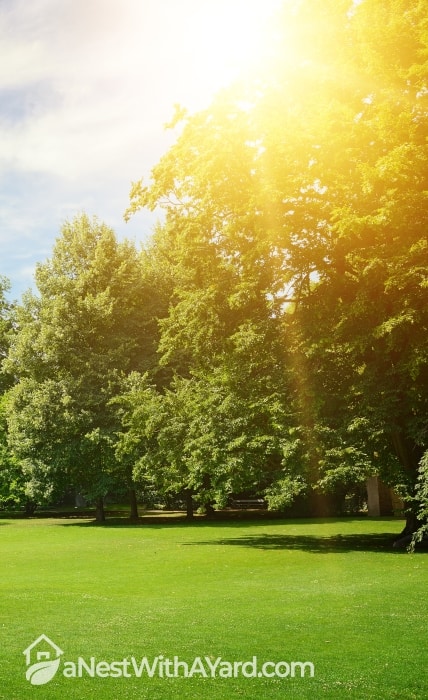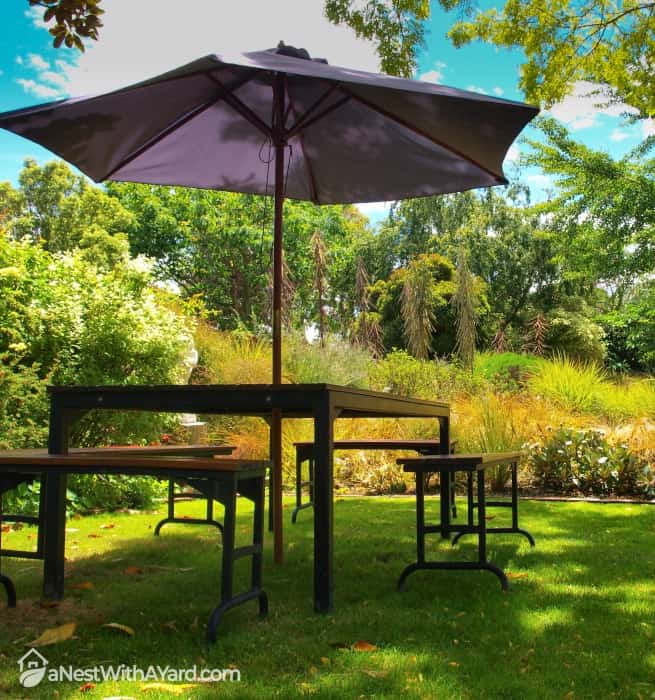Heat-stressed grass does not bounce back when stepped on, changes color to bluish-gray or brown, and starts to wilt or curl. To help your lawn, set up a regular watering schedule, postpone fertilization, keep your grass 3-3.5 inches tall, and overseed or sod the affected areas.
If your lawn is not looking its best these days, the cause of the problem might lie in high temperatures and dry weather. But, how can you recognize a heat-stressed lawn? What should you do to help heat-stressed grass?
I have faced this issue in the past. So, as usual, all you need to do is continue reading, and I’ll answer your questions and explain all you need to know. Let’s start!
Contents
What Is Heat Stress?

According to a scientific study conducted by S.V. Krishna Jagadish and Danielle A. Way, climate change affects the phenology, physiological performance, and productivity of plants. As heat waves become more frequent and global temperatures rise, plants struggle to survive, grow and yield. And grass is no exception.
An article published by the National Center for Biotechnology Information defines heat stress or high temperature (HT) stress as a major environmental stress that occurs worldwide and inhibits the growth and productivity of plants.
As I understand, grass (and plants in general) go through a number of biochemical processes to grow and develop. These processes are sensitive to high temperatures, and that is why your lawn responds negatively to heat stress.
What Causes Lawn Heat Stress?

As explained by the professionals from TurfGator, a lawn care and pest control company and member of the Illinois Landscape Contractors Association, heat stress is caused by three major factors:
- Heat
- Humidity
- Lack of water (dry weather)
You know how you feel when you spend too much time in the sun without having a drink? Well, your grass feels the same way. That is why you should try to prevent heat stress or at least react as soon as you notice the first symptoms. In my experience, prevention is a better option. Once heat stress occurs, you’ll need far more time and resources to make your lawn healthy again.
4 Ways To Recognize Heat-Stressed Grass

Thanks to a great article written by Janice Nelson from JC’s Landscaping, I have learned how to recognize the signs of lawn heat stress. Here are the most common signs:
Grass Does Not Bounce Back Easily

Step on your grass and check if it bounces back quickly. If not, your grass needs to be watered more frequently. You must maintain the appropriate water pressure within the grass blades for them to be taut and resilient.
Grass Blades Are Wilting & Rolling Up

If the grass blades begin to wilt or curl, that’s a clear sign of heat stress. Nicole Sanchez from Oregon State University explains that if plants appear wilted during the hottest part of the day but recover that evening or the next morning, you are likely dealing with heat stress. The longer a plant is exposed to stress, the greater the chances of permanent damage.
Grass Changes Color To Bluish-gray Or Brown

Discoloration is one of the most obvious signs of lawn stress caused by heat. I also picked up on that problem once my green lawn turned brown. Beware, though, that many other problems can have the same effect on your grass.
Brown Patches Or Bare Areas Start To Appear In Your Lawn

If you make the same mistake I did back when I was a lawn-care rookie and you don’t recognize and treat the first three symptoms I‘ve listed here in a timely manner, you’ll soon notice brown patches and bare soil.
Once this happens, you are in for a long recovery process. If it’s any consolation, I managed it, and I believe you can do it too.
How To Help Your Heat-Stressed Lawn – 3 Solutions

Now that I taught you how to recognize lawn heat stress, all that is left for you to learn is how to prevent it or fix the problems it has already caused. Kristine Lang, an assistant professor and SDSU Extension consumer horticulture specialist, suggests you should do the following:
Deep Watering

Summer heat calls for more water. If your soil is too dry, your grass will suffer from heat stress. The solution is to water your grass deeply in the morning or early evening, two to three times a week. I have found a great video on this subject:
Appropriate Fertilization

Do not fertilize your lawn during a heatwave. I once made that mistake and scorched my grass. As Lang explained, nutrients promote growth, but new grass is more susceptible to heat damage.
Provide Shade

Securing temporary shade can help maintain a healthy lawn during prolonged periods of hot weather. Professor Lang suggests using:
- Patio umbrellas
- Shade sails
- Gunny sack curtains
If your lawn has to deal with a lot of foot traffic and heavy mowing equipment, chances are it will suffer from soil compaction. Experts from Lawn Doctor say that compact soil brings enough trouble on its own, but, when combined with hot weather, the situation becomes critical since the air and water cannot reach the grass roots.
To resolve this issue, you’ll have to aerate your lawn. I use a rolling lawn aerator, but you can also use lawn aerating sandals or a garden fork.
Extra Advice:
Avoid cool-season grasses if you live in the lower latitudes of the USA, where summers are hot and humid. Professionals from the renowned Pennington company warn that cool-season grasses do not handle extended summer heat well. When exposed to heat stress, a cool season grass is likely to turn brown or even go dormant.
FAQs
How long does it take for grass to recover from heat stress?
There is no one answer for how long it takes for grass to recover from heat stress. It depends on the damage. Your grass might get better as soon as you water your lawn, but if the problem is severe and requires planting grass seed, recovery will take much longer.
Should you mow heat stressed lawn?
You should mow heat stressed lawn, as long as you do it properly. Lawn care experts from JC’s recommend keeping grass 3-3.5 inches tall because longer grass blades provide shade and retain more water. They also advise mowing in the early morning or evening.
What does heat stress look like on grass?
Heat stress on grass looks like wilting, change of color to bluish-gray or brown, and loss of its ability to bounce back after being stepped on. Professionals from Heritage Lawns & Irrigation company warn that brown spots and weeds are sure signs that your lawn is extremely stressed.
My Final Thoughts

As you can see, summer lawn care can be quite tricky. I hope you’ll avoid problems now that you know how to recognize the signs of heat stress and what you need to do about them.
Remember, even though there is a way to resolve a problem, it is much easier to prevent it! Hence, water, fertilize, and mow your lawn properly, and react as soon as you notice the first stress symptoms.
If you have any issues, let me know. Please share this article to help others too! The greener our lawns, the more beautiful our neighborhoods will be!
